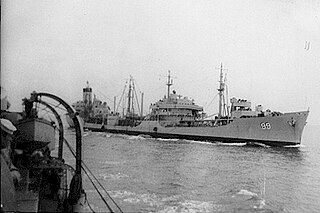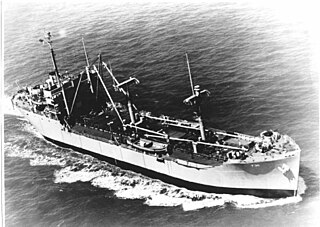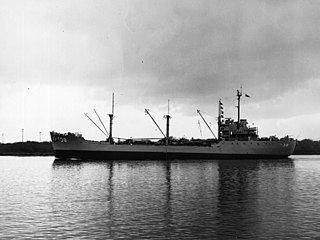
USS Santa Barbara (AE-28) was an Kilauea-class ammunition ship in the United States Navy. Santa Barbara is both the name of Santa Barbara, California and a historically active volcano on Terceira Island in the Azores. In addition, Saint Barbara is the patron saint of those who work with cannons and explosives.

USS Detroit (AOE-4) was the fourth and last Sacramento-class fast combat support ship built for the United States Navy. She was laid down on 29 November 1966 by Puget Sound Naval Shipyard, Bremerton, Washington; launched 21 June 1969; and commissioned on 28 March 1970. She is the fifth United States Navy ship named after Detroit, Michigan, the largest city in the state of Michigan, and the river of the same name.

USS Nantahala (AO–60), the second ship of this name, was laid down under Maritime Commission contract by Bethlehem Sparrows Point Shipyard, Inc., Sparrows Point, Maryland, on 31 October 1943. Launched on 29 April 1944; sponsored by Miss Mary Louise Reed; delivered to the Navy 19 June 1944; and commissioned the same day.

USS Sylvania (AFS-2), a Mars-class combat stores ship, was the second ship of the United States Navy to be named Sylvania.

USS Celtic (AF-2) was a Celtic-class stores ship acquired by the U.S. Navy for use in the Spanish–American War. She served again during World War I in the dangerous North Atlantic Ocean, delivering general goods and ammunition to American Expeditionary Force troops in Europe.

USS Caloosahatchee (AO-98) was a Cimarron-class fleet oiler constructed for the U.S. Navy for use in World War II but commissioned too late for service in that conflict. However, she had a lengthy career during the Cold War that followed. She was the only U.S. Navy ship to bear the name Caloosahatchee, after the Caloosahatchee River in southwest Florida.

USS Canisteo (AO-99) was a Cimarron-class fleet oiler constructed for the United States Navy in the closing days of World War II. Commissioned too late for service in that conflict, she had a lengthy career in the Cold War that followed. She was the only U.S. Navy ship to bear the name Canisteo, after the Canisteo River in New York.

USS Hyades (AF-28) was the lead ship of her class of stores ships acquired by the U.S. Navy for service in World War II. Her task was to carry stores, refrigerated items, and equipment to ships in the fleet and to remote stations and staging areas.

USS Lioba (AF-36) was an Adria-class stores ship in service with the United States Navy from 1945 to 1955. She was scrapped in 1973.

USS Merapi (AF-38) was an Adria stores ship acquired by the U.S. Navy for service in World War II, named after Mount Merapi, the mountain in Java, Indonesia. Her task was to carry stores, refrigerated items, and equipment to ships in the fleet, and to remote stations and staging areas.

USS Alstede (AF-48) was an Alstede-class stores ship acquired by the U.S. Navy at the end of World War II. Her task was to carry stores, refrigerated items, and equipment to ships in the fleet, and to remote stations and staging areas.

USS Arcturus (AF-52) was an Alstede class stores ship stores ship acquired by the U.S. Navy. Her task was to carry stores, refrigerated items, and equipment to ships in the fleet, and to remote stations and staging areas.

USNS Grommet Reefer (T-AF-53) was a Grommet Reefer-class stores ship acquired by the U.S. Navy. Her task was to carry stores, refrigerated items, and equipment to ships in the fleet, and to remote stations and staging areas.

USS Aludra (AF-55) was an Alstede-class stores ship acquired by the U.S. Navy. Her task was to carry stores, refrigerated items, and equipment to ships in the fleet, and to remote stations and staging areas.

USS Denebola (AF-56) was a Denebola-class stores ship acquired by the U.S. Navy. She was built as SS Hibbing Victory as a type VC2-S-AP2 Victory ship built by Oregon Shipbuilding Corporation of Portland, Oregon, under a Maritime Commission. The Maritime Administration cargo ship was the 113th ship built. Its keel was laid on 2 May 1944. The ship was christened on 30 June 1944. She was built at the Oregon Shipbuilding yards in just 59 days, under the Emergency Shipbuilding program for World War II. The 10,600-ton ship was constructed for the Maritime Commission. She was operated by the (Pacific-Atlantic SS Company under the United States Merchant Marine act for the War Shipping Administration. The other two ships in her class were USS Regulus and USNS Perseus. USS Denebola's task was to carry stores, refrigerated items, and equipment to ships in the fleet, and to remote stations and staging areas.

USS Regulus (AF-57) was a Denebola-class stores ship acquired by the United States Navy. Her task was to carry stores, refrigerated items, and equipment to ships in the fleet, and to remote stations and staging areas.

USS Procyon (AF-61) was an Alstede-class stores ship in service with the United States Navy from 1961 to 1972, following commercial service from 1943 to 1961. She was scrapped in 1986.

USS Bellatrix (AF-62) was an Alstede-class stores ship in service with the United States Navy from 1961 to 1968, following commercial service from 1945 to 1961. She was scrapped in 1969.

USS Pawcatuck (AO-108) was a T3 Ashtabula class replenishment oiler tanker that served in the U.S. Navy from 1946 to 1975, then transferred to the Military Sealift Command to continue in non-commissioned service with a civilian crew as United States Naval Ship USNS Pawcatuck (T-AO-108). She was the only United States Navy ship to bear the name Pawcatuck.

USS Pecatonica (AOG-57) was a Patapsco-class gasoline tanker in service with the United States Navy from 1945 to 1946 and from 1948 to 1961. She was then transferred to the Taiwanese Navy where she served as ROCS Chang Pei (AOG-307/AOG-507) until 2005.





















